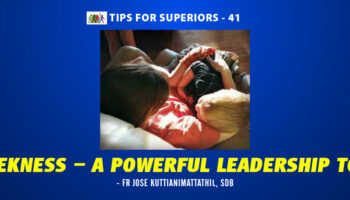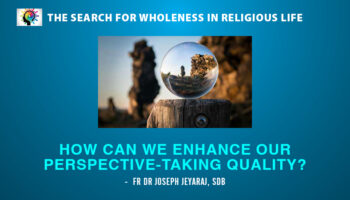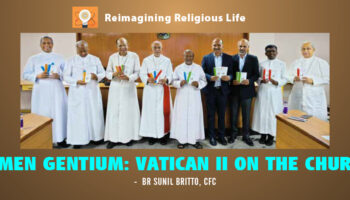Keep Watch is a Letter from the Congregation for Institutes of Consecrated Life and Societies of Apostolic Life released on 8 September 2014. It was released during the Year of Consecrated life (30 November 2014 to 2 February 2016). Basically, it speaks about Consecrated Life as a Journey, a journey like the Exodus, trying to search for the face of God and move beyond passing concerns. Here are the major points of the document.
A. Consecrated Life as Exodus
The journey of the Israelites was a journey with God through the symbols of a cloud by day and a flame by night. “At every stage of their journey, whenever the cloud rose from the tabernacle, the sons of Israel would resume their march. If the cloud did not rise, they waited and would not march until it did. For the cloud of the LORD rested on the tabernacle by day, and a fire shone within the cloud by night, for all the House of Israel to see. And so it was for every stage of their journey (Ex 40:36-38).” This evocative icon of Exodus indicates a modern image of Consecrated Life. It includes our modern moments of stop and go, pause and resume, patience and enterprise.
Exodus is full of symbols and metaphors: The burning bush, crossing the red sea, journey through the desert, the theophany on mount Sinai, fear of the lonely wilderness, the gift of the law of the covenant, the column of cloud and fire, manna, water. The symbol of the desert signifies arid solitude and loneliness, lack of basics of life (water, vegetation, friends, life).
The Symbol of the Cloud (anan): It is a guide for the journey, at times stopping for long time, thus causing inconvenience and provoking complaint, then, rising and moving to show the way. The cloud indicated constant watchfulness, test of faith, patience, and final destination indefinitely postponed, leading to total obedience. The symbolic meaning of the cloud is interpreted as the angel of God (Ex14:19), presence of God, used again and again in psalms and wisdom books, and even in the New Testament (cloud during the birth of Jesus, the Transfiguration, the Ascension).
Consecrated Life Today: It is a kind of journey guided by the cloud in the Post-Conciliar era. It is a journey of exodus. There have been moments of creative fidelity, inventiveness, enthusiasm; so too fragile certainties and bitter disappointments, like walking in darkness at times and watchful prayer. Consecrated life is an unknown voyage (Wisdom18:3), a journey that demands total obedience, trust and faith. It is like the journey of Abraham, who was asked to move to an unknown destination.
B. Living the Exodus
Consecrated Life has evolved into the present form through a journey like Exodus. This evolution can be seen during the second half of the last century:
- 1947: Introducing Secular Institutes was a revolutionary gesture in the Church.
- 1950: The Vatican called the first World Congress of all Religious.
- 1964: Lumen Gentium, 6th Chapter (on religious life) brings an ecclesial identity to Religious Life.
- 1965: Perfectae Caritatis. Decree giving importance to fraternal life and formation (educational formation of religious).
- Pacem in Terris introduces new concept (“signs of the times”), rights and duties, human dignity and even UN Universal Declaration of the Human Rights. Consecrated life has tried to meet these demands, inviting religious to the image of the cloud with trust and obedience through the voice of the Church.
- The theology of Charism begins with Vatican II though not mentioned in Vatican II.
- 1971: The word charism first appears in the Apostolic Exhortation Evangelica Testificatio of Paul VI.
- The Church guided the Consecrated Life in the last fifty years on these seven main themes:
- The foundational charism,
- life in the spirit nourished by the Word (lectio divina),
- fraternal life in common,
- initial and continuing formation,
- new forms of apostolate,
- the exercise of authority and
- attention to different cultures.
C. Consecrated Life as Elijah’s Life
The monastic life is compared to the life of Prophet Elijah: Solitude, asceticism, passion for the covenant, fidelity to the law, defence of poor and passing the mantle as prophetic sign (6). Elijah defends the poor in condemning Ahab and Queen Jezebel. Encountering the poor widow, fighting for her life, depression in the desert at Beersheba and surviving on bread and water, prophetic defence against Baal–these are the other life events that can be compared to Consecrated Life today. He goes through purification and reaches enlightenment finally at Mount Horeb. In the experience of dark nights, he experiences the theophany of God in the gentle breeze. God is a whisper, not visible but present. Elijah’s begging for rain in a crouching position and taking refuge in a cave in crouching position indicate the image of an unborn baby. Thus, he gives rebirth to the new paths of the living God.
Religious men and women should not lose sight of the movement of the cloud. We should try to recognise God in small and frail signs. We might hear an echo of Elijah’s servant, who repeats, searching the horizon: There is nothing! (1 Kgs 18:43). We are called to the grace of patience, to wait and return to searching the sky even seven times (12).
D. Centrality of the Gospel in Religious Life
Religious Life is following the Gospel (8). “St. Dominic showed himself everywhere as an evangelical man in words and deeds.” For Francis of Assisi, the Rule is: “The life of the Gospel of Jesus Christ;” For Clare of Assisi: “The form of life of the order of four sisters… is this: ‘To observe the holy Gospel of our Lord Jesus Christ.’” In the rule of the Carmelites, the fundamental precept is that of “meditating on the Law of the Lord day and night.” James Alberione affirmed that the Pauline Family: “Aspires to live the Gospel of Jesus Christ to the full.” Little Sister Magdeleine has said: “We must build something new; something new that is old, that is the authentic Christianity of the first disciples of Jesus. We have to take up the Gospel word for word.” Every charism of consecrated life is rooted in the Gospel.
Conclusion
We are called to move along these paths, opposing the dia-bolical that divides and separates, and liberating the sym-bolical, meaning the primacy of the bond and relationship present in the complexity of created reality (15).
The heart of that bond is God, revealed in Jesus Christ.

To subscribe to the magazine Contact Us





